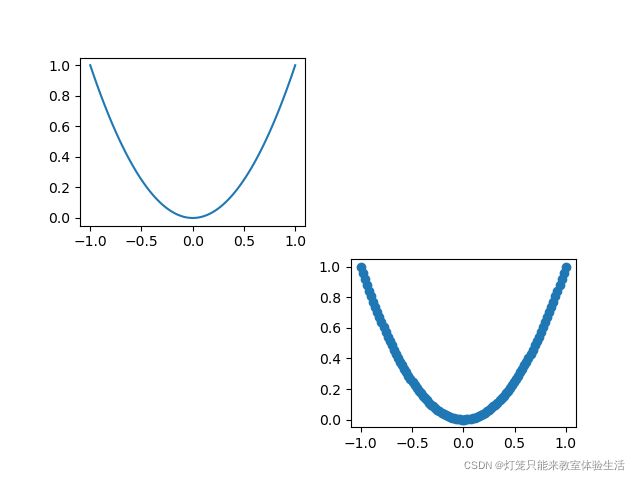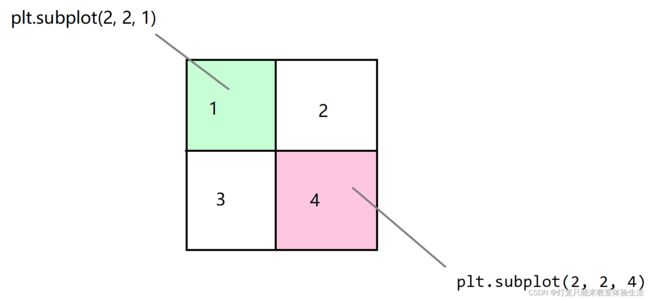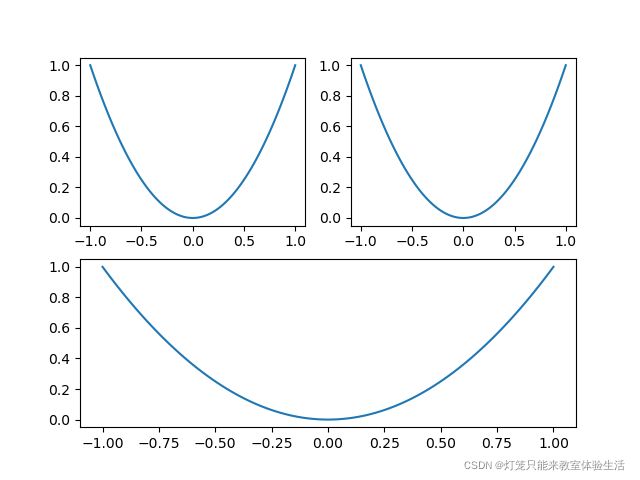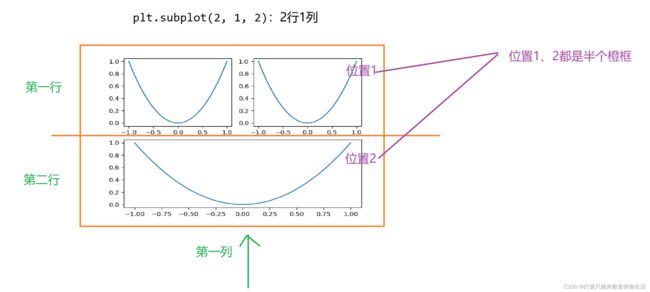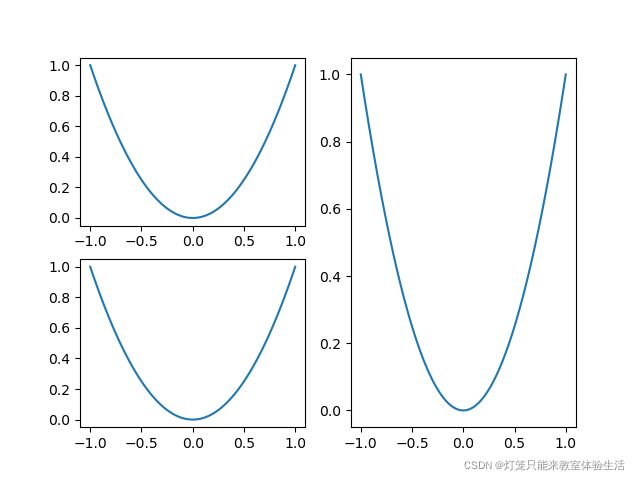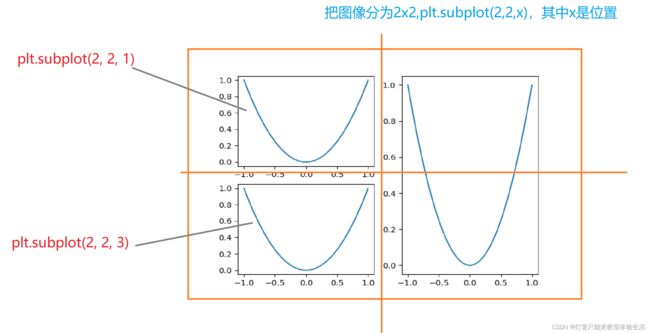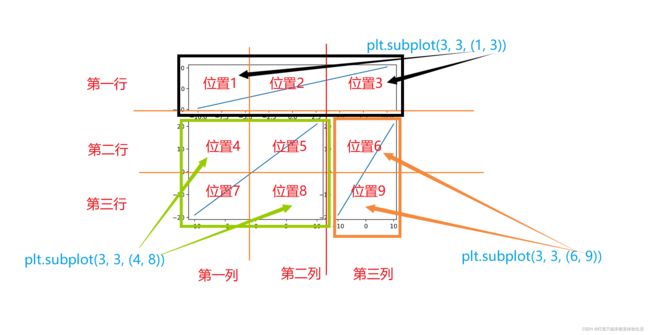matplotlib画多个图(着重讲图片的位置如何摆放)
前言
所有的图都是基于函数 y = x^2,但图像不是重点,如何作图才是重点。
希望你能耐心看到最后。
文章目录
- 前言
- 使用整型确定位置
-
- 1.
- 2.
- 3.
-
- 图例的位置
- 4.
- 5.
- 6.
-
- 6.1: p1~p4, p8,p9
- 6.2:p5
- 6.3:p6
- 6.4:p7
- 使用元组确定位置
- 示例1
使用整型确定位置
1.
import matplotlib.pyplot as plt
import numpy as np
x = np.linspace(-1, 1, 100)
print(type(x))
y = x ** 2
plt.figure(1)
plt.subplot(2, 2, 1)
plt.plot(x, y)
plt.show()
np.linspace(-1, 1, 100):获取[-1,1]之间的100个点,以numpy.ndarray形式返回
figure(1):创建一张画布,并且编号为1
plt.subplot(2, 2, 1):将画布分为2×2,第一个是行,第二个是列,且在第一个位置作图。
- 2x2显然是4个位置:
2.
x = np.linspace(-1, 1, 100)
print(type(x))
y = x ** 2
plt.figure(1)
plt.subplot(2, 2, 1)
plt.plot(x, y)
plt.subplot(2, 2, 4)
plt.scatter(x, y)
plt.show()
plt.subplot(2, 2, 4):将画布分为2×2,在第四个位置作图。
plt.scatter(x, y):以x为横轴坐标、y为纵轴坐标,绘制散点图。
3.
x = np.linspace(-1, 1, 100)
print(type(x))
y = x ** 2
plt.figure(1)
plt.subplot(2, 2, 1)
plt.plot(x, y, label='1')
plt.legend(loc=2)
plt.subplot(2, 2, 2)
plt.plot(x, y, label='2')
plt.legend(loc=2)
plt.subplot(2, 2, 3)
plt.plot(x, y, label='3')
plt.legend(loc=2)
plt.subplot(2, 2, 4)
plt.plot(x, y, label='4')
plt.legend(loc=2)
plt.show()
plt.plot(x, y, label='4'):绘制折线图,图例为4。
plt.legend(loc=2):图例的位置设为2。
图例的位置
x = np.linspace(-1, 1, 100)
print(type(x))
y = x ** 2
plt.figure(1)
plt.subplot(2, 2, 1)
plt.plot(x, y, label='1')
plt.legend(loc=1)
plt.subplot(2, 2, 2)
plt.plot(x, y, label='2')
plt.legend(loc=2)
plt.subplot(2, 2, 3)
plt.plot(x, y, label='3')
plt.legend(loc=3)
plt.subplot(2, 2, 4)
plt.plot(x, y, label='4')
plt.legend(loc=4)
plt.show()
4.
x = np.linspace(-1, 1, 100)
print(type(x))
y = x ** 2
plt.figure(1)
plt.subplot(2, 2, 1)
plt.plot(x, y)
plt.subplot(2, 2, 2)
plt.plot(x, y)
plt.subplot(2, 1, 2)
plt.plot(x, y)
plt.show()
plt.subplot(2, 2, 1):把画布分为2x2,且在1位置。
plt.subplot(2, 2, 2):把画布分为2x2,且在2位置。
plt.subplot(2, 1, 2):把画布分为2x1,且在2位置。
5.
x = np.linspace(-1, 1, 100)
print(type(x))
y = x ** 2
plt.figure(1)
plt.subplot(2, 2, 1)
plt.plot(x, y)
plt.subplot(2, 2, 3)
plt.plot(x, y)
plt.subplot(1, 2, 2)
plt.plot(x, y)
plt.show()
plt.subplot(2, 2, 1):把画布分为2x2,且在第一个位置
plt.subplot(2, 2, 3):把画布分为2x2,且在第三个位置
plt.subplot(1, 2, 2):把画布分为1x2,且在第二个位置
6.
虽然很多,但是别怕,我都会讲的。
x = np.linspace(-1, 1, 100)
print(type(x))
y = x ** 2
plt.figure(1)
plt.subplot(4, 4, 1)
plt.plot(x, y, label='p1')
plt.legend(loc=2)
plt.subplot(4, 4, 2)
plt.plot(x, y, label='p2')
plt.legend(loc=2)
plt.subplot(4, 4, 3)
plt.plot(x, y, label='p3')
plt.legend(loc=2)
plt.subplot(4, 4, 4)
plt.plot(x, y, label='p4')
plt.legend(loc=2)
plt.subplot(4, 1, 2)
plt.plot(x, y, label='p5')
plt.legend(loc=2)
plt.subplot(2, 2, 3)
plt.plot(x, y, label='p6')
plt.legend(loc=2)
plt.subplot(4, 2, 6)
plt.plot(x, y, label='p7')
plt.legend(loc=2)
plt.subplot(4, 4, 15)
plt.plot(x, y, label='p8')
plt.legend(loc=2)
plt.subplot(4, 4, 16)
plt.plot(x, y, label='p9')
plt.legend(loc=2)
plt.show()
6.1: p1~p4, p8,p9
我们可以发现,这张画布的第一行都是一样的图,倒数两个也是同样的图(因为用的是同样的分割方法4x4)。
对于4x4的画布,这4个子图就相当于1x1的图。
plt.subplot(4, 4, x):将画布分为4x4,并且在第x个位置

6.2:p5
6.3:p6
6.4:p7
使用元组确定位置
plt.subplot(n_row, n_col, (first, last))
其中:
n_row:行数
n_col:列数
(first, last):表示左上角位置和右下角位置
示例1
评论区中有同学问,3x3的图,在(4,5,7,8)位置画图,该怎么画?
这用上面的方法是不行的,位置必须传一个二元组
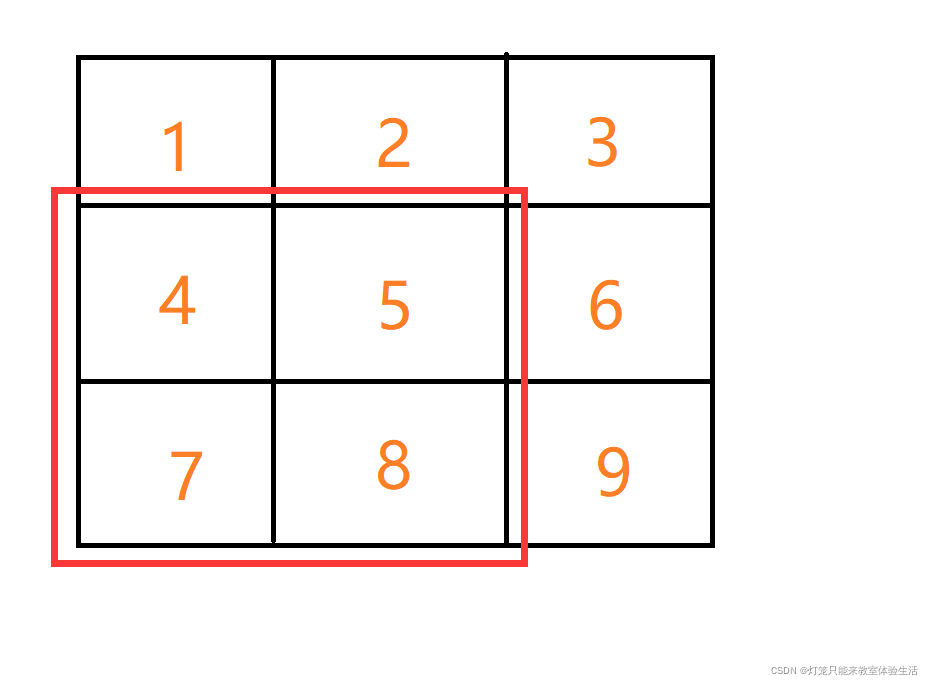
import matplotlib.pyplot as plt
import numpy as np
x = np.linspace(-10, 10, 100)
y = [2*i + 1 for i in x]
plt.figure(1)
plt.subplot(3, 3, (1, 3)) # 左上角是位置1,右下角是位置3
plt.plot(x, y)
plt.subplot(3, 3, (4, 8)) # 左上角是位置4,右下角是位置8
plt.plot(x, y)
plt.subplot(3, 3, (6, 9)) # 左上角是位置6,右下角是位置9
plt.plot(x, y)
plt.show()


